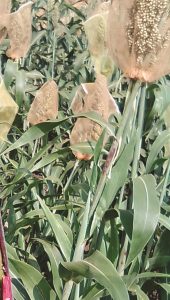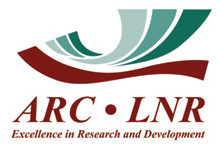
 Thulo Sejake,
Thulo Sejake, ARC-Grain Crops, Potchefstroom
Sorghum is a major human food source in several African countries where agricultural and environmental conditions are unfavourable for other cereal crops. There is an increasing body of evidence and awareness of the beneficial health-promoting properties of sorghum. In South Africa, sorghum meal is often eaten as a stiff porridge much like pap, which is referred to as mabele.
Other important uses of sorghum include stover and molasses for livestock feed and biofuel. The threat of climate change on crop productivity is high, particularly in the semi-arid regions where higher temperatures and increases in rainfall variability could substantially have negative impacts on food security. To address this challenge, a move toward more climate-resilient crops such as sorghum is of great importance. Development of adapted varieties remains very important, and cultivation of sorghum is expected to expand as an adaptation to climate change.
Diseases and insects, in addition to abiotic stresses (for example drought, poor soil conditions and heat), are major factors limiting yield potential of sorghum cultivars. Among many foliar diseases of sorghum, anthracnose (Colletotrichum sublineolum) and leaf blight (Exserohilum turcicum) are the most common to grain and forage sorghum production in South Africa. Anthracnose is widely prevalent under warm, humid conditions. It infects all parts of the sorghum plant, causing yield losses of up to 70% and reducing quality.
Leaf blight is also a most damaging foliar disease of sorghum and is widespread in many humid areas of the world. If leaf blight is established on susceptible cultivars before panicle emergence, grain yield losses may be up to 50%. High levels of loss occur if the disease establishes itself before the boot stage. The grain is not infected, although the debilitating effects of leaf blight may reduce yield and grain weight.
Over the last two growing seasons 200 sorghum accessions in the ARC-Grain Crops germplasm bank were evaluated for anthracnose and leaf blight under natural infestation at Potchefstroom and Cedara experimental farms. The common reaction symptoms of sorghum plants to anthracnose and leaf blight disease infections are shown in Photo 1 to Photo 3. The diseases were more severe in the 2021/2022 summer season as compared to 2020/2021, which was due to the higher rainfall that favoured the development of these diseases.



 Most of the genotypes evaluated (Graph 1) were found resistant to both leaf blight and anthracnose, indicating that they can be useful as sources of resistance in breeding programmes. The best control strategy for these foliar diseases is using integrated pest management methods that include crop rotation, weed control, resistant cultivars, crop debris management, and use of registered foliar fungicides where such practices are economically or practically viable.
Most of the genotypes evaluated (Graph 1) were found resistant to both leaf blight and anthracnose, indicating that they can be useful as sources of resistance in breeding programmes. The best control strategy for these foliar diseases is using integrated pest management methods that include crop rotation, weed control, resistant cultivars, crop debris management, and use of registered foliar fungicides where such practices are economically or practically viable.



























